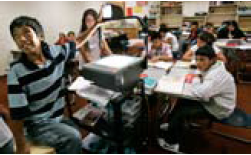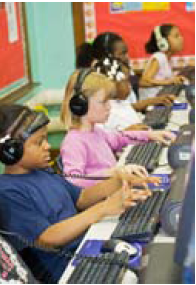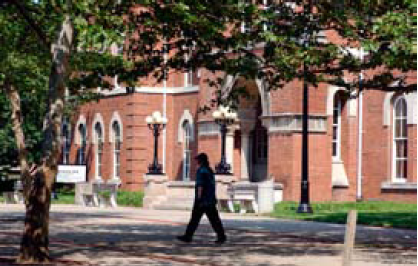

International Baccalaureate students in Washington State respond to a science question.
For someone from another country, the U.S. educational system understandably appears large and varied, even chaotic. Within this complexity, however, American education reflects the history, culture, and values of the changing country itself. From a broad perspective, the American educational system can be characterized by its large size, organizational structure, marked decentralization, and increasing diversity.
Size
Schools in the United States — public and private, elementary and secondary, state universities and private colleges — can be found everywhere, and the United States continues to operate one of the largest universal education systems in the world. More than 75 million children and adults were enrolled in U.S. schools and colleges in the 2005-2006 academic year, according to the National Center for Education Statistics. Another 6.8 million were employed as teachers, teaching kindergarten through college.
In addition, more than a million preschool children from low-income families, usually ages three and four, attend Head Start programs designed to provide learning, social development, and nutrition programs to ensure that these preschoolers will be ready for school at age five or six.
Public school enrollments grew exponentially during the post-World War II “baby boom” generation (usually defined as those born from 1946 to 1964). After a drop-off in the 1980s, enrollments have rebounded strongly, largely as a result of growing Hispanic populations, according to the latest U.S. Census Bureau reports.
The U.S. educational system today comprises almost 96,000 public elementary and secondary schools, plus more than 4,200 institutions of higher learning, ranging from small, two-year community colleges to massive state universities with undergraduate and graduate programs in excess of 30,000 students. The nation’s total expenditures for education stand at approximately $878 billion a year.

Preschoolers listen to a story in a Head Start classroom.
K-12 Organization
School attendance is compulsory for students through age 16 in most states. Children generally begin elementary school with kindergarten (K) at age five and continue through secondary school (grade 12) to age 18. Typically, the elementary school years include kindergarten through grades five or six, and at some schools through grade eight. Secondary schools — known as high schools in the United States — generally include grades nine through 12.
Fifty years ago, elementary school students typically moved immediately to high school, or they attended junior high school for grades seven and eight or grades seven, eight, and nine. During the past 30 years, however, junior high schools have been largely replaced with middle schools configured for grades six through eight, or roughly for the same grades as junior high. Estimates are that 20 million young people, ages 10 to 15, attend middle schools today.
As Minnesota principal Mark Ziebarth described the difference between the two approaches, “A junior high school program is designed to mirror a traditional high school program for students at a younger age. It has a similar schedule to the high school and classes are arranged by departments. Middle schools are designed to provide a forum to meet the special needs of adolescents.”
Team teaching and flexible block scheduling, rather than set 45- or 50-minute classes, are characteristic of middle schools. These schools also place emphasis on small groups, on an interdisciplinary approach to subject matter, and on special projects that can engage 10- to 15-year-olds, who, says the National Middle School Association, “are undergoing the most rapid intellectual and developmental changes of their lives.”
The large contemporary high school, offering a broad menu of academic and elective courses for students ages 14 to 18, became a fixture in American education by the mid-20th century. High school students also can choose from a host of clubs, activities, athletics, work-study arrangements, and other extracurricular activities. Based on grades and tests, students can take advanced academic courses or more general or vocational classwork.
Through most of the 20th century, high schools were consolidated into larger units to offer wider class choices to more and more students. The rural country school almost disappeared, replaced by countywide high schools. In cities, it was not uncommon for large school campuses to hold as many as 5,000 students with both college-oriented and vocational courses that could appeal to just about everyone.
More recently, concerns over the caliber of education in such large schools has led to a call for the establishment of smaller schools with lower student-teacher ratios.
The contemporary American high school has long loomed large in the public culture. The popular musical Grease, the television series Happy Days, and movies like Blackboard Jungle depicted the light and dark sides of schools in the 1950s. Recent popular entertainments with high school settings range from films like Mean Girls, Juno, Election, and High School Musical to such hit TV shows as Beverly Hills 90210 and Saved by the Bell.

English language learners in a middle-school in Grand Island, Nebraska.
Private Schools
Private schools flourish in the United States; many of these schools are run by churches and other religious organizations. Of the estimated 55.8 million children attending elementary and secondary schools during the 2007-2008 academic year, about 6 million, or 11 percent, were enrolled in private schools.
More than half of the nation’s private school students attend Catholic schools, the nation’s oldest private school system. Other private schools reflect America’s religious diversity, encompassing nearly all major Protestant denominations and the Quaker, Islamic, Jewish, and Greek Orthodox faiths.
The country’s oldest private schools, however, are elite boarding schools, founded in the 18th century, which have had a record of educating many of the country’s intellectual and political leaders.
Another 1.1 million students are home-schooled by their parents under guidelines established by each of the 50 states, according to recent census figures.
Local Control
Perhaps the most remarkable characteristic of American education is its decentralization. Schools in the United States have been, and remain, overwhelmingly a state and local responsibility. Unlike most other nations, the United States does not operate a national education system — with only a few exceptions, notably the nation’s military academies and Native American schools. Neither does the federal government approve nor administer a national curriculum.
Public education constitutes the single largest expenditure for almost every U.S. city and county, which receive the bulk of their funding from local property taxes. Local boards of education, most of which are elected, administer the nation’s nearly 15,500 school districts, ranging from small rural schools in states like Kansas and Nebraska to the New York City system, which educates more than a million children annually.
State boards of education, along with a state superintendent or commissioner, oversee local education districts, set student and teacher standards, approve the classroom curriculum, and often review textbook selections. The state’s chief power, however, is increasingly financial: Most states now provide substantial aid to schools to supplement local tax revenues.
One consequence of local control and financing of public schools has been disparities between affluent and poor school districts. In recent years, under pressure from state courts and public advocacy groups, many states have taken steps to ensure more equitable funding of school districts regardless of income levels.
The federal government provides research and support to ensure equal access and excellence in education, along with funding student loan programs and assistance to lower income students. Nevertheless, responsibility for education remains primarily a state and local enterprise. According to the U.S. Department of Education, about 90 percent of the annual expenditures for education at all levels comes from state, local, and private sources.

Working in the computer lab in a Detroit, Michigan, elementary school.
Diversity
Schools in the United States have experienced waves of immigration throughout their history, and today American schools, like the larger society they serve, are more ethnically diverse than ever. In the early 20th century, children of immigrant families — most from southern and eastern Europe — flooded public school systems in the Northeast and Midwest. Today new immigrants continue to change the ethnic composition of student populations, although the largest numbers now come from Latin America and Asia.
African Americans constitute about 17 percent of the K-12 student population; Hispanics, however, are becoming the largest single minority group in public schools. It is not uncommon to find schools, especially along the East and West Coasts, where more than a dozen different languages, from Arabic to Vietnamese, are spoken at home by students of foreign-born parents. As a result, the teaching of English as a second language remains one of education’s most important responsibilities.
Despite their decentralization and diversity, public schools remain remarkably cohesive in the ways they are run. A student transferring from a school in California to one in Pennsylvania or Georgia will find differences no doubt, but the mix of academic subjects will be largely familiar, despite the fact that the federal government does not mandate a national curriculum.

Ohio State University, one of the first land-grant universities, established in 1873.



















